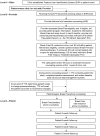A cluster randomized controlled trial for a multi-level, clinic-based smoking cessation program with women in Appalachian communities: study protocol for the "Break Free" program
- PMID: 35164857
- PMCID: PMC8842942
- DOI: 10.1186/s13722-022-00295-5
A cluster randomized controlled trial for a multi-level, clinic-based smoking cessation program with women in Appalachian communities: study protocol for the "Break Free" program
Erratum in
-
Correction to: A cluster randomized controlled trial for a multi-level, clinic-based smoking cessation program with women in Appalachian communities: study protocol for the "Break Free" program.Addict Sci Clin Pract. 2022 Apr 1;17(1):21. doi: 10.1186/s13722-022-00304-7. Addict Sci Clin Pract. 2022. PMID: 35361240 Free PMC article. No abstract available.
Abstract
Background: The cervical cancer burden is high among women living in Appalachia. Cigarette smoking, a cervical cancer risk factor, is also highly prevalent in this population. This project aims to increase smoking cessation among women living in Appalachia by embedding a smoking cessation program within a larger, integrated cervical cancer prevention program.
Methods: The broader program, the Take CARE study, is a multi-site research collaborative designed to address three risk factors for cervical cancer incidence and mortality: tobacco use, human papillomavirus (HPV) infection, and cervical cancer screening. Break Free is a primary care clinic-based implementation program that aims to promote smoking cessation among female smokers in Appalachia by standardizing clinical practice protocols. Break Free includes: (1) implementation of a tobacco user identification system in the Electronic Health Record, (2) clinic staff and provider training on the Ask, Advise and Refer (AAR) model, (3) provider implementation of AAR to identify and treat women who want to quit smoking within the next 6 months, (4) facilitated access to cessation phone counseling plus pharmacotherapy, and (5) the bundling of Break Free tobacco cessation with HPV vaccination and cervical cancer screening interventions in an integrated approach to cervical cancer prevention. The study spans 35 Appalachian health clinics across 10 healthcare systems. We aim to enroll 51 adult female smokers per health system (total N = 510). Baseline and follow-up data will be obtained from participant (provider and patient) surveys. The primary outcome is self-reported 12-month point prevalence abstinence among enrolled patients. All randomized patients are asked to complete follow-up surveys, regardless of whether they participated in tobacco treatment. Data analysis of the primary aims will follow intent-to-treat methodology. Secondary outcomes will assess program implementation and cost effectiveness.
Discussion: Addressing high tobacco use rates is critical for reducing cervical cancer morbidity and mortality among women living in Appalachia. This study evaluates the implementation and effectiveness of a smoking cessation program in increasing smoking cessation among female smokers. If results demonstrate effectiveness and sustainability, implementation of this program into other health care clinics could reduce both rates of smoking and cervical cancer. Trial registration NCT04340531 (April 9, 2020).
Keywords: Cervical cancer prevention; Clinic-based interventions; Implementation science; Rural health; Smoking cessation.
© 2022. The Author(s).
Conflict of interest statement
The authors declare that they have no competing interests.
Figures
References
-
- Appalachia’s population (2014–2018). https://www.arc.gov/report/appalachias-population-2014-2018/.
-
- Lengerich EJ, Tucker TC, Powell RK, Colsher P, Lehman E, Ward AJ, Siedlecki JC, Wyatt SW. Cancer incidence in Kentucky, Pennsylvania, and West Virginia: disparities in Appalachia. J Rural Health. 2005;1:39–47. - PubMed
-
- The Appalachia Community Cancer Network: The cancer burden in Appalachia. 2009.
Publication types
MeSH terms
Associated data
Grants and funding
LinkOut - more resources
Full Text Sources
Medical
Miscellaneous




